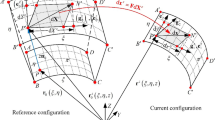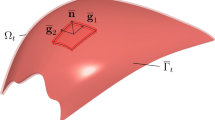Summary
An axisymmetrical shell element for large plastic strains is developed. The theory is based on the multiplicative decomposition of the material deformation gradient into an elastic and a plastic part. For quasi-Kirchhoff-type axisymmetric shells this leads to a product of the elastic and plastic stretches. By introduction of logarithmic strains the decomposition becomes additive. Plastic incompressibility is fulfilled in an exact manner.
Similar content being viewed by others
References
Eberlein, R.;Wriggers, P.;Taylor, R. L.: A fully non-linear axisymmetrical quasi-Kirchhoff-type shell element for rubber-like materials. Int. J. Num. Meth. Eng. 36 (1993) 4027–4043
Eterovic, A. L.;Bathe, K. L.: A hyperelastic-based large strain elasto-plastic constitutive formulation with combined isotropic-kinematic hardening using logarithmic stresses and strain measures. Int. J. Num. Meth. Eng. 30 (1990) 1099–1115
Gruttmann, F.;Stein, E.: Tangentiale Steifigkeitsmatrizen bei Anwendung von Projektionsverfahren in der Elastoplastizitätstheorie. Ing. Arch. 58 (1988) 15–24
Hill, R.: The mathematical theory of plasticity. Oxford: University Press 1950
Hill, R.: Constitutive inequalities for isotropic elastic solids under finite strain. Proc. R. Soc. London A 314 (1970) 457–472
Hoger, A.: The stress conjugate to logarithmic strain. Int. J. Solids Struct. 23 (1987) 1645–1656
Lee, E. H.;Liu, D. T.: Finite-strain elastic-plastic theory with application to plane-wave analysis. J. Appl. Phys. 38 (1967) 19–27
Lubliner, J.: A maximum-dissipation principle in generalized plasticity. Acta Mechanica 52 (1984) 225–237
Lubliner, J.: Normality rules in large-deformation plasticity. Mech. Mater. 5 (1986) 29–34
Mattiasson, K.; Bernspång, L.; Samuelsson, A.; Hamman, T.; Schedin, E.; Melander, A.: Evaluation of a dynamic approach using explicit integration in 3-D sheet forming simulation. In: Chenot, J. L.; Wood, R. D.; Zienkiewicz, O. C. (eds.) Proc. NUMIFORM '92 Conf. 1992
Massoni, E.;Chenot, J. L.;Bellet, M.: A 3-D finite element approach for predicting the deformation of an anisotropic elasto-plastic membrane. In: Wriggers, P.; Wanger, W. (eds.) Nonlinear Computational Mechanics. Berlin: Springer 1991
Peric, D.; Owen, D. R. J.; Honnor, M. E.: A model for finite strain plasticity. In: Owen, R.; Hinton, E.; Onate, E. (eds.) Proc. 2nd Int. Conf. on Computational Plasticity, Pineridge, Swansea, 1989, pp. 111–126
Saran, M. J.;Schedin, E.;Samuelsson, A.;Melander, A.;Gustafsson, C.: Numerical and experimental investigations of deep drawing of metal sheets. J. Eng. Ind. ASME, 112 (1990) 272–277
Simo, J. C.;Taylor, R. L.: A return mapping algorithm for plane stress elastoplasticity. Int. J. Num. Meth. Eng. 22 (1986) 649–670
Simo, J. C.: A framework for finite elastoplasticity based on maximum plastic dissipation and the multiplicative decomposition: Part I. Continuum formulation. Comp. Meth. Appl. Mech. Eng. 66 (1988) 199–219
Simo, J. C.;Taylor, R. L.;Wriggers, P.: A note on finite-element implementation of pressure boundary loading. Comm. Appl. Num. Meth. 7 (1991) 513–525
Simo, J. C.: Algorithms for static and dynamic multiplicative plasticity that preserve the classical return mapping schemes of the infinitesinal theory. Comp. Meth. Appl. Mech. Eng. 99 (1992) 61–112
Wagner, W.: A finite element model for non-linear shells of revolution with finite rotations. Int. J. Num. Meth. Eng. 29 (1990) 1455–1471
Weber, G.;Anand, L.: Finite deformation constitutive equations and a time integration procedure for isotropic, hyperelastic-viscoplastic solids. Comp. Meth. Appl. Mech. Eng. 79 (1990) 173–202
Wriggers, P.;Miehe, C.: Contact constraints within coupled thermomechanical analysis-A finite element model. Comp. Meth. Appl. Mech. Eng. 113 (1994) 301–319
Wriggers, P.;Simo, J. C.: A note on tangent stiffnesses for fully nonlinear contact problems. Comm. Appl. Num. Meth. 1 (1985) 199–203
Zienkiewicz, O. C.;Taylor, R. L.: The Finite Element Method, Vol. 1. London: McGraw Hill 1988
Author information
Authors and Affiliations
Additional information
Support for this work was provided by the Deutsche Forschungsgemeinschaft (DFG) under contract Wr 19/7-1. The financial aid for the first and second author is gratefully acknowledged.
Rights and permissions
About this article
Cite this article
Wriggers, P., Eberlein, R. & Gruttmann, F. An axisymmetrical quasi-Kirchhoff-type shell element for large plastic deformations. Arch. Appl. Mech. 65, 465–477 (1995). https://doi.org/10.1007/BF00835659
Received:
Accepted:
Issue Date:
DOI: https://doi.org/10.1007/BF00835659




